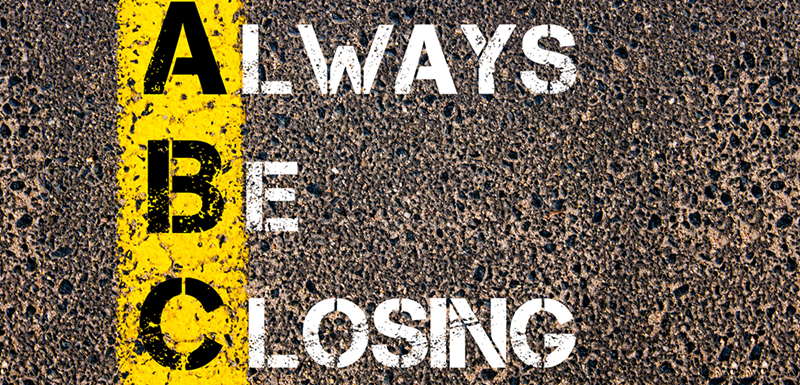Sales professionals all have different methods for closing their customers. For business-to-business sales, there are short and long sales cycles which have totally different methods of closing. The same goes for business-to-consumer sales, as there are also short and long sales cycles with totally different methods. The KISS (“Keep it Short and Simple”) and ABC (“Always be Closing”) principles are regularly reiterated among the sales community. Sales professionals can sound robotic while using these principles, and prospects are over it! Consultative sales processes enable you to be unique by managing your sales close using positive reinforcement.
You have had an opportunity to get to know your customer. You know what they have in place today, you know what’s working and what’s not working. You know who the stakeholders are and what aspects of your product or service will work best for them. You have completed an orderly presentation during which you have organized and presented your product or service information with key benefits that meet the customer’s needs and desires, and you have portrayed the big picture to them. You have outlined the cost and return on investment for them, and now it’s time to close.
Sales professionals use the principle “Always Be Closing” to dictate that with each objection or concern there needs to be a return to a closing statement. This is effective in that it brings the customer back to closing statements and directs the conversation in a positive direction. This tactic keeps the customer from going off topic or becoming distracted, both of which eventually lead them to say they need to think about it, at which point they end the conversation. Keep them focused on the close.
A closing statement essentially asks:
- “Where should I send the bill?”
- “What’s the address where we will send the shipment?”
- “Will you be the one signing the contract? If not, who am I contacting instead?”
- “What day and time is best for delivery of the product?”
- “Who will be part of the development team for the implementation of the service?”
These are all examples of good, thoughtful, specific closing questions. Salespeople are taught to listen, answer the question, and then return to the closing questions needed in order to process the order. More importantly, for the position of control, sales professionals need to maintain control of the conversation to keep it moving forward.
Another closing tactic is actively handing the customer a pen to sign the paperwork. These sorts of things are fine when you know someone well enough, but if you don’t and you haven’t built credibility or set the right expectations, then you might come across as pushy. Sure, they might sign, but they may never do business with you again. If they sign today and the buy, is it worth it to you that they may not give you a referral or buy again? I don’t think it is. I’ve worked very hard in my life, but looking back, I can say I’ve learned to work smarter and have more fun than work. Yes, I said have fun.
I had three sales calls yesterday. On the first call, we talked about personal stuff, as I asked her how she’s doing, how’s the family and her doggies of course. We then chatted about the business and their plans in the next few months. We finished talking about the services for about three minutes, then agreed on when they would sign a new three-year deal. Then we closed with a fun conversation about installing a new kitchen.
On my next call, my customer and I chatted about the weird weather and natural disasters. I mentioned the three options of services, and he listened as I went over the expectations, and we agreed on the next call we would finalize. It’s that simple.
When I was a young saleswoman, I was very serious about product knowledge, naming the benefits one after another. When I lost a sale, I would keep trying to find more and more customers. Today, I work with the same people for years and years; a close is no longer a long drawn-out meeting, it is merely a quick chat that just identifies the best option in terms of need and value for my customer, and an agreement on when they will sign. My relationship is as a trusted advisor because I’ve proven year after year to be that trusted counsel their business needs.
Think of yourself as a trusted advisor. During the introduction you qualified yourself and the customer by learning what they have and areas of need. If you know your product will serve them well, don’t beg them for the sale. With a bit of an attitude of indifference (essentially non-verbally saying, “I’m not going to starve if you don’t sign”), show them with confidence that this product or service is right for them.
Keep it short and simple, focusing on exactly what’s relevant to them (which is what you found out from them during the introduction and their questions during the presentation). You know what’s right for them, and you have already presented. It’s time to get the answers to the questions which lead to your close. If you don’t feel confident, then try light-hearted or humorous banter. For instance, ask, “What would keep you from signing this agreement today?”

Or, “Why wouldn’t you want to sign up?”
By asking for specific objections, you’re forcing them to give you the answers they have to think about and information that they might not give you once they’ve said “no”. This helps you to understand how to overcome their objections, but most importantly to understand them and their motivation. If you like people (and I hope you do if you’re working in sales), then you will enjoy your time with them. Savor the art of developing relationships with your prospects and have fun with them.
Spend the extra time at the beginning of the relationship to find out who they are, what their goals are, what they do for their company, and all the details that will help you direct them choose the right product or service for them. Find out how they buy, when they buy, and what’s included in their budgeting plans for the year. The more you know, the better you can serve them and therefore meet your sales quota.
Look at How to Qualify Your Prospect, Sales Objections in the Close and Overcoming Objections in the Presentation to help fine tune your sales style. Remember, relationships first! Listen to your customer, then present based on what you’ve learned, and then finally go for the close. You will know when it’s the right fit for them, and you can make them feel just as sure by being confident, instilling trust, and staying focuses and to the point.
Subscribe for more sales, business, and investing posts. Have a lovely day!











